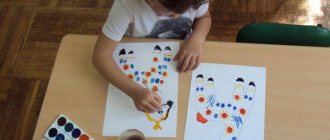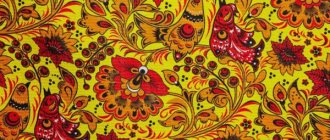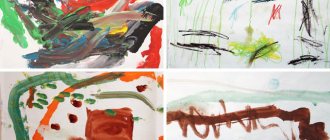Making a Dymkovo toy
The figurines are made by hand from red clay mixed with sifted sand. The creation process consists of several stages.
Modeling
A clay toy is molded in parts. First, the torso of the figurine is made from clay dough, then the remaining small parts are attached to it using liquid clay. The joints at the places where the parts are fastened are smoothed with a damp cloth. The product is leveled with wet fingers.
Lady
If you need to make, for example, a lady, then the first step is to fashion her cone-shaped skirt, to which her body with an elongated neck is then attached. The head is made from a ball attached to the neck. Below, hands are formed from a clay sausage. Then comes the time for details: the lady has a curled hairstyle, she is wearing a fashionable hat or kokoshnik, she has a painted shawl on her shoulders, and in her hands is a small handbag or a baby.
Animals
The animal is made a little differently. For example, a horse is made like this: short legs are attached to a cylindrical body, and a head with an elongated muzzle is attached to a curved neck. Small details of the figure - small ears, tail and mane.
Drying
Before firing, the toy must be dried. The drying time depends on the size of the figurine and the conditions in the workshop - air temperature, humidity, etc.
This process can last either 2-3 days or 2-3 weeks.
Burning
In ancient times, products were fired in a Russian oven, placing them on an iron baking sheet directly above the firewood. When the figures became red hot, they were left to cool in the oven.
Today, firing is carried out using special electrical equipment, which is safer and less labor-intensive.
Whitewash
During the firing process, the clay craft becomes red-brown in color. Before applying ornaments, the figurine must be whitened.
For whitewashing, a solution consisting of crushed chalk diluted in milk is used. When the milk sours, the solution becomes solid, covering the entire surface of the figurine with an even layer.
Despite attempts to improve the composition and method of its application, the ancient tradition of whitewashing is still preserved. Experiments with the composition were unsuccessful: it was not possible to achieve a perfect white color, and the new solutions themselves dried unevenly. True, in some cases it is possible to deviate from tradition. For example, when children paint clay toys with their own hands, you can whitewash them with regular gouache.
Colors
When the whitewash has dried, you can begin painting. Patterns are applied to the product with bright colors.
|
If you dilute the primary colors with chalk, you can get additional shades. For example, diluted blue turns into cyan.
The old masters did the painting not with brushes, but with a wooden stick wrapped in linen scraps. Such a tool allowed them to make only the simplest elements of the ornament: lines, diamonds, circles, zigzags. Today, when painting, they use brushes made of ferret or kolinsky hair.
To add shine to the figurine, a raw egg is added to the paint. The final touch is to decorate the toys with small figures cut out of gold leaf leaves.
|
painting
|
The pattern is not invented in advance; it appears during painting and depends on the size and image of the toy. Therefore, craftswomen say that form and decor are closely related, and no two crafts are absolutely identical.
The figures drawn on the toys seem simple and uncomplicated, but the ornament of the products is symbolic.
- The wavy line resembles a river, a surface of water.
- A circle with a dot is the sun.
- Cells of intersecting lines - a log house.
All these concepts occupy an important place in the Russian person’s picture of the world.
Dymkovo painting in kindergarten and school
The study of Dymkovo toys is included in the training program in children's creative studios and art schools. They also pay attention to it in fine arts classes in kindergarten and secondary schools.
This folk craft is part of the history of our country, and bright figurines decorated with symbolic ornaments can tell a lot about the life and worldview of our ancestors.
Painting a Dymkovo toy in a simplified form is accessible to young children who are interested in drawing small diamonds, circles, and stripes on animal figures. Older children can even try to fashion a toy themselves according to Dymkovo canons.
System of images and plots
If we compare the surviving images of the first products with modern examples of this folk art, we cannot help but notice that over hundreds of years their creators have stepped far forward. The toy got rid of the simplicity of its form and ornamentation and became more decorative, and the number of plots increased significantly.
Although craftsmen claim that no two figures are absolutely identical, five main typical groups can be distinguished:
- Female images (young ladies and mistresses, nannies and nurses with a child in their arms, water bearers). The ladies have corsets and crinolines, umbrellas in their hands, fashionable hats and outfits; nurses in kokoshniks, wide skirts, aprons with frills. Static figures full of majesty and dignity.
- Cavaliers are often depicted on horseback in profile. Compared to women's images, they are smaller in size and look simpler.
- Animals . Initially, figurines were created depicting totem animals: a ram, a goat, a deer, a bear, and images of various domestic animals were gradually added. A distinctive feature of this type: an upturned head and short legs, widely spaced. Often the figures are “dressed up” in bright colorful costumes of musicians with instruments in their hands.
- Birds (roosters, turkeys, ducks). Ducks have lush capes, roosters and turkeys have bright, curly tails.
- Compositions . They can include both people and animals. They present various scenes from Russian city and village life: tea drinking, folk festivals, sleigh rides and many others.
A distinctive feature of Dymkovo toys is that they expand at the bottom. Ladies have fluffy bell-shaped skirts, gentlemen have horses, and animals have stable legs. If the figures had thin, long limbs, they would not have been able to withstand the weight of their body.
Dymkovo fishery in the 21st century
No matter how technology develops, the famous craft still remains manual. Masters create toys, carefully preserving ancient traditions. Therefore, each figurine is unique.
Dymkovo toys have been made for centuries and remain popular, being not only souvenirs, but also guardians of folk memory, a symbol of Russian folk culture.
Currently, both enthusiasts and various organizations take care of the preservation of the famous folk craft. In 2010, in the center of Kirov, with support, a monument dedicated to the Dymkovo toy was erected. It represents a family consisting of a mother with a baby in her arms, a man playing the harmonica, a boy with a whistle, as well as a cat and a dog. All figures are made in the classic Dymkovo style.
The Dymkovo toy was among the treasures of Russian art presented at the opening of the Winter Olympics in Sochi in 2014.
History of the Dymkovo toy
Let us preface the story about the Dymkovo toy with two significant facts:
- it has been made by craftsmen for over 400 years;
- These figures are known and loved not only in our country, but also abroad.
Dymkovo toys (pictures)
The pictures below will help you fully imagine the diversity and beauty of the Dymkovo toy.
The name of the craft was given by the Dymkovo settlement, where these clay figurines began to be made. For a long time this settlement has been part of the city of Kirov, which formerly bore the names Khlynov and Vyatka.
|
The great demand for clay crafts, as well as the presence of large reserves of this natural material, made Dymkovskaya Sloboda the birthplace of the famous folk craft. Of course, the appearance of the first crafts was far from canonical, but over time, the familiar appearance and ornamentation of the Dymkovo toy was formed.
The appearance of the first clay crafts in Dymkovo dates back to the 15th-16th centuries. By this time, the toy loses its sacred meaning, which determined the simplicity of its form: the pagan worldview of the Slavs and pre-Christian rituals are a thing of the past. The shape of the products begins to change, they become beautiful and colorful.
The traditions and manufacturing techniques of the first masters have been preserved to this day. The Dymkovo toy known to us today reflected elements of Russian life of the 19th century; later images of gallant gentlemen and fashionable ladies appeared.
|
Craftswomen of that time not only preserved old traditions, but also brought newness to the appearance of clay crafts, and also came up with new subjects. So craftswoman E.A. Koshkina has achieved great success in creating group compositions. Her work “Sale of Dymkovo Toys” was presented at the international exhibition in Paris in 1937 and received great fame. Craftswoman O.I. Konovalova (daughter of A.A. Mezrina) liked to create images of animals, and craftswoman E.I. Penkina preferred to embody everyday scenes in her compositions.
At the beginning of the Great Patriotic War, the production of figurines practically ceased: the Kirov region was in the rear, and its residents began to work for the front. However, the evacuees really liked the bright crafts, and the craftswomen began creating them again.









